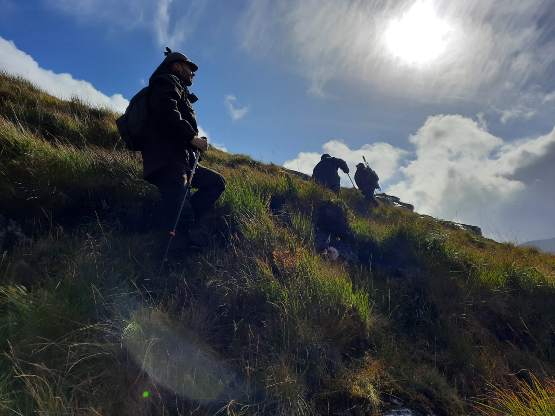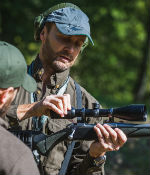Professional Deer Stalker Peter S Jones comments on amendments to the deer act in Scotland that remove close seasons for male deer.

For the first time in my career as a professional deer stalker and most likely, in a first for most of our readers, there has been a significant amendment to the 1996 Deer Act, which makes some important changes to UK deer stalking legislation.
The legislative amendments to the Deer Act will affect Scotland only and follow a deer management consultation by the Scottish Government.
The following amendments to the Deer (Scotland) Act 1996 will come into effect from 21st October and 01st November.
The amendments are as follow:
- From the 21st October 2023 the statutory closed season for all males will be removed, meaning that male deer, of all species, (Red Stag, Roebuck, Sika Stag and Fallow Buck), may be shot all year-round.
- From 01st November those that possess a night licence and are specifically authorised to do so, may use thermal imaging equipment and night vision scopes for the taking of deer at night.
- From 01st November 2023 the requirement of a minimum bullet weight to shoot the large species of deer (Red, Sika & Fallow) will be reduced from 100grains to 80grains.
In never ceases to amaze me these days, how out of touch government and government working groups are with the popular consensus.
For instance, whilst amendments to the act that allow the use of ‘night vision’ are sensible, the amendment does not allow for the that same night vision equipment to be used by the stalker during the day! An oversight maybe?
After many thousands of pounds of taxpayer’s money being spent on the consultation, is it too much to expect amendments such as these, to have been thought through properly? Under the existing amendments those that manage deer will have to change their optics for night and day use. Something which will usually require one rifle and scope combination for the day, and one for the night.
Whilst allowing those that have a night license to shoot with ‘night vision’ is sensible, failure to allow for its use during the day is just plain daft. As for the policy itself, well, so be it, suffice to say, that it seems to me, that increasingly night licences are granted not after all other means of control have been exhausted, but instead, that they are reached for, at the first hint of a problem.
Thankfully, the previous requirement to use a 100-grain bullet on Fallow, Red and Sika, being replaced, by a requirement to use 80 grains, constitutes one element of the amendment that is sensible. Countless stalkers use a .243. In fact, it remains probably one of the most widely used calibres. This amendment will allow owners of these firearms to continue to use their .243 rifles with non-lead ammunition, whilst also complying with other legislative requirements surrounding minimum legal velocity and energy.
This leads me finally, to the abolition of the statutory closed season for males.
I challenge you to find any professional stalker who thinks this is a good idea. It is blindingly daft, and I would argue, totally out of touch with the feelings of those on the ground. Not only is it ill conceived, but it may also prove to be counterproductive to the intentions of the Scottish government to reduce overall deer numbers.
I have said it before and I will say it again, even the most basic understanding of population dynamics would equip you with an appreciation, that shooting males has almost no impact on the overall population of deer. One male can ‘serve’ as many as twenty-five females, and so unless you get to grips with the breeding population, then you will have no impact on the total population.
Why might it prove to be counterproductive? Well, this is because, when some deer managers should be getting on with task of reducing females, they may now, instead elect to shoot a male.
Picture the scenario; A professional stalker in Scotland is guiding a paying client onto Red deer during a cold December morning, after a long stalk in the cold, the stalking party come across a group of stags. Does the stalker allow his client to shoot one of these stags, something that will most likely result in a greater fee and an early bath, or does he press on in search of a hinds?
Current legislation requires that the stalker press on in search of females, thereby reducing the breeding population. The new legislation does not.
Finally, and then I’ll stop, I promise. The legislation also makes the mistake of lumping all species of deer into the ‘problem’ category. Are Roe deer a serious problem on most Scottish estates? I suspect they are not, yet the native Roebuck, from which many professional stalkers derive a meagre income, may now be shot devoid of antler.
Regrettably, I suspect that this new legislation in Scotland will set a precedent and pave the way for similar changes in England & Wales. Albeit, for now, I’ll reserve comment on the outcome of that consultation.
A glimmer of hope lies with the common sense of Scottish deer managers, who, just because the legislation permits it, do not have to shoot males all year around, but may elect to designate self-imposed closed seasons of their own.
October is my favourite time of year to be stalking. It is a shame that October 2023 is tainted by these ill-considered amendments to UK deer stalking legislation.
As ever, please see below our useful breakdown of what is ‘in and out’ of season across the UK, during the month of October.
If you’d like to get out stalking this autumn, then a great platform to do so is through the Capreolus Club, County Deer Stalking’s official members club. You can find out more about membership of this thriving and friendly club here: membership-eligibility
 In Season in England & Wales: Fallow Buck, Roebuck, Muntjac Buck & Doe, Sika Stag, Red Stag.
In Season in England & Wales: Fallow Buck, Roebuck, Muntjac Buck & Doe, Sika Stag, Red Stag.
Off Season in England & Wales: Fallow Doe, Roe Doe, Sika Hind, Red Hind, CWD.
In Season in Scotland: All male deer. From 21st October: Roe Doe, Fallow Doe, Sika Hind, Red Hind.
(Peter Jones - editor)



















